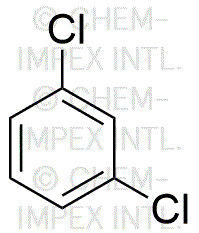1,3-Dichlorobenzene is widely utilized in research focused on:
- Solvent in Organic Synthesis: It serves as an effective solvent for various organic reactions, facilitating the dissolution of reactants and improving reaction yields.
- Intermediate in Chemical Manufacturing: This compound is crucial in producing agrochemicals and pharmaceuticals, acting as a building block for more complex molecules.
- Industrial Degreasing Agent: Its strong solvent properties make it ideal for cleaning and degreasing metal parts in automotive and machinery industries, enhancing equipment maintenance.
- Research in Environmental Studies: It is used in studies assessing environmental contamination, helping researchers understand the behavior and impact of chlorinated compounds in ecosystems.
- Analytical Chemistry: Employed as a standard in chromatography, it aids in the identification and quantification of other compounds, streamlining laboratory analyses.
Información general
Propiedades
Seguridad y normativas
Aplicaciones
1,3-Dichlorobenzene is widely utilized in research focused on:
- Solvent in Organic Synthesis: It serves as an effective solvent for various organic reactions, facilitating the dissolution of reactants and improving reaction yields.
- Intermediate in Chemical Manufacturing: This compound is crucial in producing agrochemicals and pharmaceuticals, acting as a building block for more complex molecules.
- Industrial Degreasing Agent: Its strong solvent properties make it ideal for cleaning and degreasing metal parts in automotive and machinery industries, enhancing equipment maintenance.
- Research in Environmental Studies: It is used in studies assessing environmental contamination, helping researchers understand the behavior and impact of chlorinated compounds in ecosystems.
- Analytical Chemistry: Employed as a standard in chromatography, it aids in the identification and quantification of other compounds, streamlining laboratory analyses.
Documentos
Hojas de datos de seguridad (HDS)
La SDS proporciona información de seguridad completa sobre la manipulación, el almacenamiento y la eliminación del producto.
Especificación del producto (PS)
La PS proporciona un desglose completo de las propiedades del producto, incluida la composición química, el estado físico, la pureza y los requisitos de almacenamiento. También detalla los rangos de calidad aceptables y las aplicaciones previstas del producto.
Certificados de análisis (COA)
Busque certificados de análisis (COA) ingresando el número de lote del producto. Los números de lote y de partida se pueden encontrar en la etiqueta de un producto después de las palabras "Lote" o "Lote".
Número de catálogo
Número de lote/lote
Certificados de origen (COO)
Este certificado de origen confirma el país en el que se fabricó el producto y también detalla los materiales y componentes utilizados en él y si se deriva de fuentes naturales, sintéticas u otras fuentes específicas. Este certificado puede ser necesario para cumplir con las normativas aduaneras, comerciales y regulatorias.
Número de catálogo
Número de lote/lote
Hojas de datos de seguridad (HDS)
La SDS proporciona información de seguridad completa sobre la manipulación, el almacenamiento y la eliminación del producto.
DownloadEspecificación del producto (PS)
La PS proporciona un desglose completo de las propiedades del producto, incluida la composición química, el estado físico, la pureza y los requisitos de almacenamiento. También detalla los rangos de calidad aceptables y las aplicaciones previstas del producto.
DownloadCertificados de análisis (COA)
Busque certificados de análisis (COA) ingresando el número de lote del producto. Los números de lote y de partida se pueden encontrar en la etiqueta de un producto después de las palabras "Lote" o "Lote".
Número de catálogo
Número de lote/lote
Certificados de origen (COO)
Este certificado de origen confirma el país en el que se fabricó el producto y también detalla los materiales y componentes utilizados en él y si se deriva de fuentes naturales, sintéticas u otras fuentes específicas. Este certificado puede ser necesario para cumplir con las normativas aduaneras, comerciales y regulatorias.


